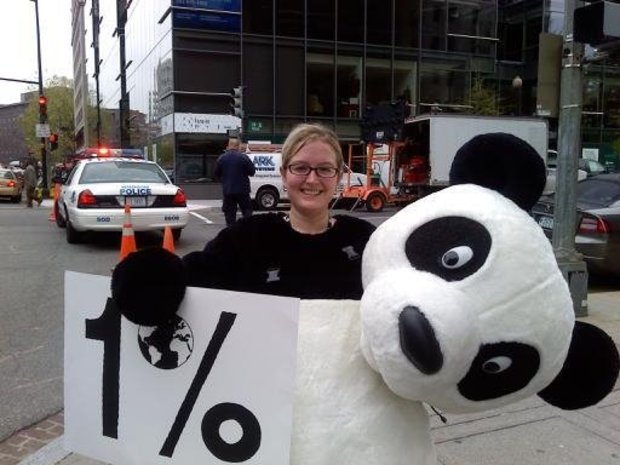Meet One of the Faces Inside the WWF Panda Suit [Q&A]
Jennafer Bonello is a manager in the media and external affairs department of WWF’s US office, working to conserve and safeguard the planet.

Jennafer Bonello is donning the panda suit to raise awareness for WWF's global activities.
With over 50 years experience, the World Wildlife Fund (WWF) is a well-known advocate of conservation, working in over 100 different countries across the world. Whether it’s saving endangered species or rallying for climate change, WWF is at the forefront of saving the planet. Jennafer Bonello is a manager in the media and external affairs department of WWF’s US office, and her exciting job has taken her to South Africa to see WWF’s Black Rhino Range Expansion Project in action. Find out more about the inspiring work of WWF and how Jennafer and her fellow “pandas” are making a real difference in safeguarding our earth.
1. What is your organization’s mission?
World Wildlife Fund's (WWF) mission is to conserve nature and reduce the most pressing threats to the diversity of life on Earth. Our vision is to build a future in which people live in harmony with nature.
2. What makes you guys different from the rest?
For more than 50 years, WWF has been protecting the future of people and nature. We work in over 100 countries and tackle substantial and critical problems with innovative, large-scale solutions. WWF’s unique way of working combines global reach with a foundation in science, involves action at every level from local to global, and ensures the delivery of innovative solutions that meet the needs of both people and nature. For example, last year through an unprecedented collaboration, WWF and our partners secured permanent protection of 150 million acres of the Brazilian Amazon rainforest. It was the largest tropical forest conservation project in history.

Bonello and some of the WWF team at the People's Climate March in New York City, September 2014.
3. Offices or open work space?
Open work space, which sets the stage for many great conversations. We also have communal work spaces and an innovation room where people can brainstorm the next great conservation idea. Another space called Habichat serves as a gathering area for meetings and parties. WWF headquarters also has the third largest green roof in Washington, DC – pretty neat!
4. What three words describe your organization?
Dedicated, passionate and collaborative – we know we can’t do this work alone. We rely on many partners from individuals, policy makers, business and community leaders to achieve our conservation goals.
5. What inspires you?
The people on the ground making a difference – the rangers, our scientists and program officers getting after urgent conservation challenges. We’re up against a tough battle to end wildlife crime. In June I witnessed our experts at a farm in Maryland testing camera equipment and related software that will be used in eastern Africa to track poachers and stop them from killing rhinos and elephants. Being with our scientists in the field and seeing first-hand what they do renews my passion for WWF’s mission. I’ve had the opportunity to meet many enthusiastic WWF supporters – most recently at the Rock ‘n’ Roll Seattle™ marathon through our Panda Nation program. Talking to people who care deeply about the work we do is very inspiring.

Getting outside of the office, Bonello can be seen here in Costa Rica with WWF.
6. What is the best part about your job?
Working with the best and the brightest! My team’s energy is contagious – we work hard and know how to have a lot of fun. At a meeting recently, I sang just about every Disney song with my boss. Not sure where else I’d be able to do that!
Experiencing WWF’s work on the ground is really inspiring. Last year I was fortunate enough to visit South Africa where I saw our scientists tag and collar rhinos as part of WWF’s Black Rhino Range Expansion Project. Seeing our program staff in action and the majestic rhinos up close in such a remote, beautiful place was an experience I’ll never forget.
And I’d be remiss if I didn’t mention “Panda Fridays” – (the office is closed every other Friday, hence the name, “Panda Fridays”).
7. Does your team eat lunch together?
Pandas love food! We eat lunch together pretty much every day! In our “panda café” or common area lunch room.
8. Facebook or Twitter?

Meeting local supporters at the Rock ‘n’ Roll Seattle™ marathon through the Panda Nation program.
9. What do you want Goodnet users to know about your organization?
WWF is about more than just saving pandas. While protecting wildlife and their habitats remains at the heart of what we do, WWF is addressing the larger global threats that impact our everyday lives – threats like climate change and resource scarcity. How do we make sure our forests, our freshwater and our food are sustainable and remain healthy for generations to come? These are the complex problems we’re trying to get after.
10. How can people get involved?
Educate yourself about the issues you care about by visiting worldwildlife.org and take action! Join millions of WWF activists that are making a difference for our planet. On WWF’s action page you can join WWF and ask global leaders to implement policies that will conserve fresh water around the world.






